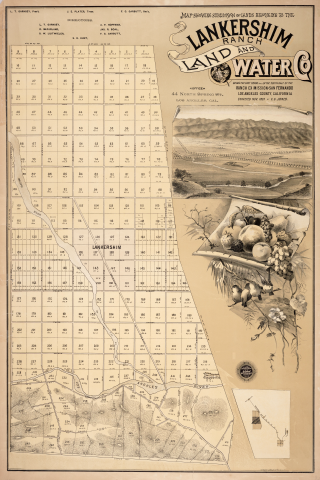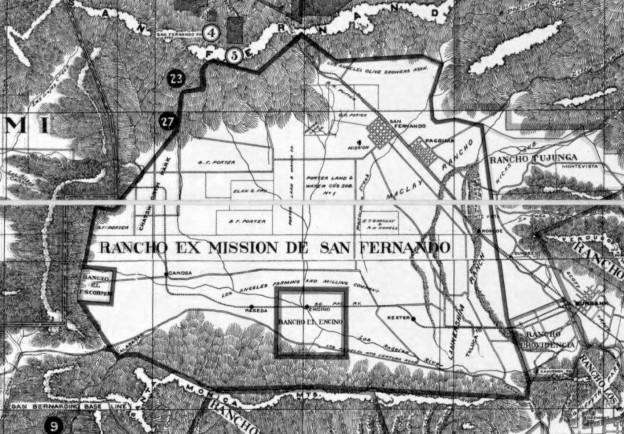
The Lankershim interest in 1887, as it was presented to the public when the railroad made possible the sale of farm and house lots. This land comprises today’s North Hollywood, Universal City, Studio City, Toluca Lake, and Valley Village (VV is just to the left of the big bulge on the Tujunga wash, center.)
Note the inset: it is advertising the adjacency of the projected city to the new Southern Pacific line, with its connections to Los Angeles and Pasadena.
Isaac Lankershim bought title to this land from Pio Pico himself in 1869: 60,000 acres of Rancho Ex-Mission San Fernando, sold for $115,000. Lankershim was backed by Bay Area investors, incorporated as the “San Fernando Valley Farm and Homestead Association.” The parcel was conveniently adjacent to the Cahuenga Pass, and perfectly delectably green and well-watered, yet it came with no water rights at all. Rights to the entire watershed were vested in the City of Los Angeles, which had jealously guarded them since Felipe de Neve granted them in 1781. Even if Pico had let cattle muddy the waters in the past, he couldn’t any more, now that the Yankees were running the City of Los Angeles.
The Valley’s herd of free-roaming, branded longhorn cattle had practically disappeared in the previous ten rainless, hot, dry, dusty years. Drought in the 1860′s had collapsed most of the ranchos, and with them went the economy that had flourished during the Gold Rush.
As far as Pico was concerned, the only thing you could do with Valley land was run cattle, and since you couldn’t do that anymore, why not sell? Pico used the money to build the Pico House, LA’s swankest Plaza hotel.
Through the 1870′s Lankershim used his fertile, water-less ranch to pioneer organic dry wheat farming. And this, on a truly Californian scale, with a score of harvesters working with 20-mule teams to pull massive wood-and-cast-iron combines across miles of Valley hard-pack. Lankershim then contrived to ship his wheat abroad in huge quantities, I believe, to Eastern Europe and to China.
Orchards, of course, were the other way to use this land, and use it they did. By the twenties, when the City of Lankershim changed its name to North Hollywood. it was unofficially known nationwide as “the Land of the Peach”. The SF Lemon Growers Association, Sunkist Oranges, and Diamond Walnuts, were some of the big co-operative growers associations that shipped through North Hollywood.


